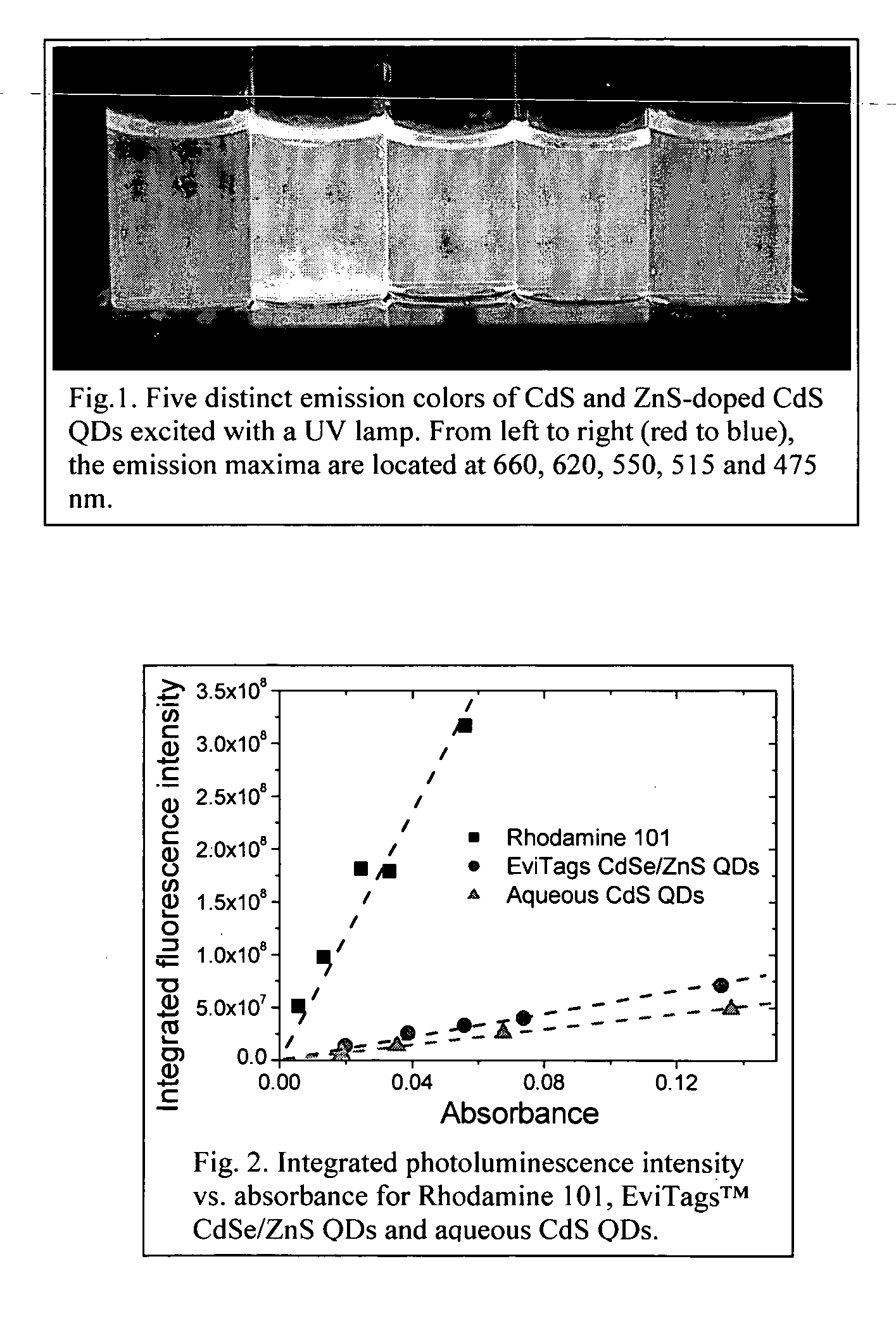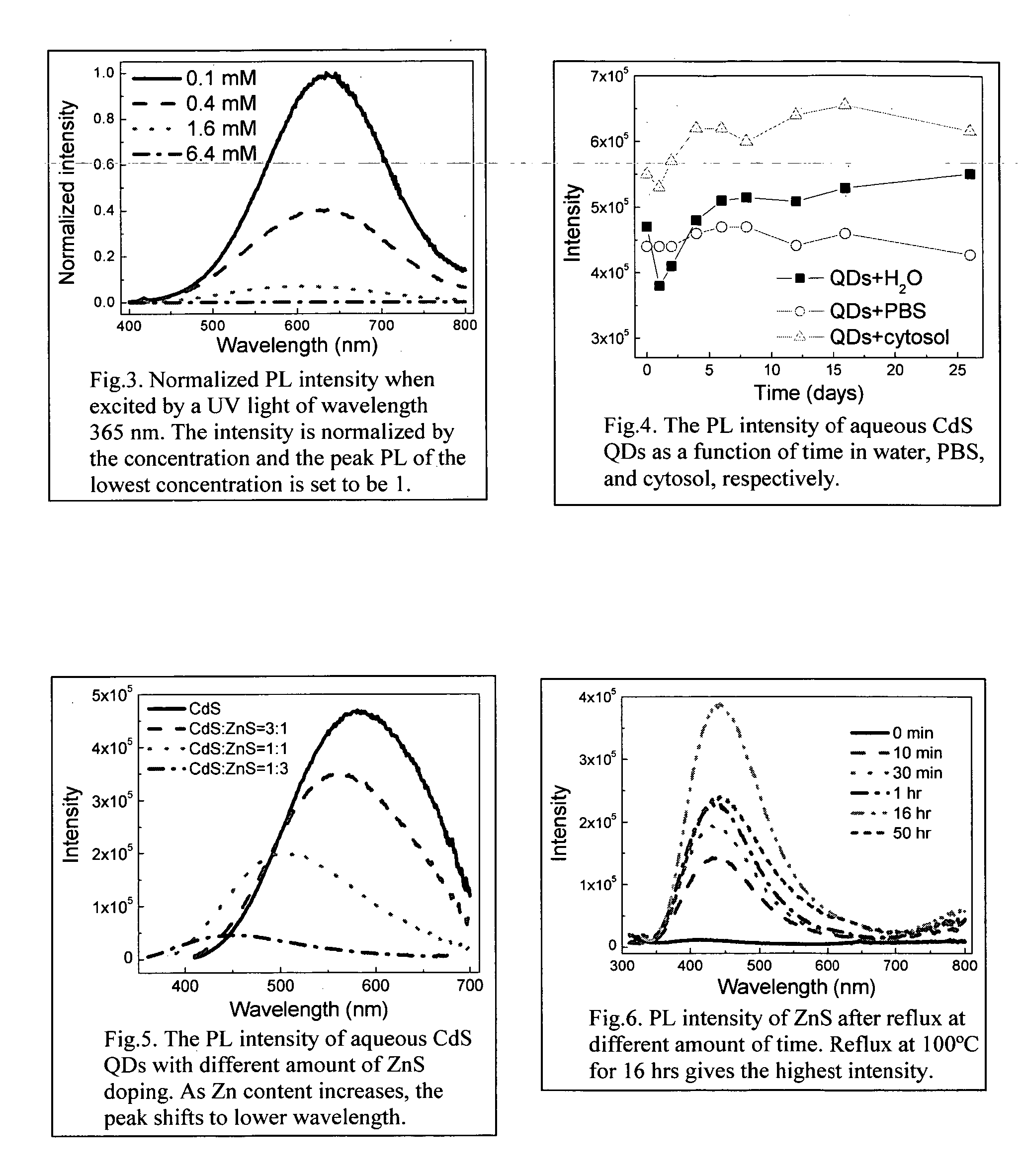Synthesis of water soluble nanocrystalline quantum dots and uses thereof
a nanocrystalline, water-soluble technology, applied in the field of photoluminescent nanocrystalline quantum dots, can solve the problems of inability to meet the requirements of synthesis, so as to achieve the effect of improving the emission spectra
- Summary
- Abstract
- Description
- Claims
- Application Information
AI Technical Summary
Benefits of technology
Problems solved by technology
Method used
Image
Examples
example i
Aqueous Synthesis of CdS QDs
[0031] 1.6×10−4 mol Cd(NO3)2, 1.6×10−4 mol Na2S, and 3.2×10−4 mol MPA, respectively, were prepared and each was dissolved into about 33 ml deionized water with stirring. The Cd(NO3)2 solution was added to the MPA solution at 2 ml / min with continuous stirring. NH4OH (1 M) was added to the mixed solution to adjust the pH value to a pH of about 7-9. The Na2S solution was then quickly poured into the mixed solution and stirred for about 3-5 min. All of the above process steps were performed in an oxygen-free environment. In the present example, these steps were performed in a sealed glove bag pumped with nitrogen flow. An ultrasonicator was used to apply sonication for about 5-10 min. Large agglomerates were removed by filtration, as necessary. CdS nanoparticles were obtained in a clear suspension. The suspension was quenched in a freezer to 0C, and the suspension was stored in a refrigerator at about 4° C.
example ii
Aqueous Synthesis of ZnS QDs
[0032] The procedure was the same as in the example I, except that the chemical precursor Cd(NO3)2 was replaced by Zn(NO3)2. After the ZnS QDs were prepared, the suspension was refluxed at 100° C. for several hours to help improve the photoluminescence properties.
example iii
Aqueous Synthesis of CdS QDs with ZnS Doping
[0033] 0.8×10−4 mol Cd(NO3)2 and 0.8×10−4 mol Zn(NO3)2, respectively, were prepared and each dissolved into 16 ml deionized water with stirring. 1.6×10−4 mol Na2S and 3.2×10−4 mol MPA, respectively, were weighed and each dissolved into 33 ml deionized water with stirring. The Cd(NO3)2 solution was added into the MPA solution and then the Zn(NO3)2 solution was added into MPA solution at about 2 ml / min with continuous stirring. Thereafter, the process described in Example I was followed. The CdS with ZnS doping (1:1) QDs are obtained as a clear suspension. Other doping ratios can be employed by adjusting the Cd to Zn molar ratio.
[0034] Quantum Yield
[0035] To obtain the quantum yield of the aqueous CdS QDs, Rhodamine 101 was used as the standard sample, and the commercial QDs were compared. All the measurements were performed at the same conditions for Rhodamine 101, for the commercial EviTags™ CdSe / ZnS QDs and for the aqueous CdS QDs of t...
PUM
| Property | Measurement | Unit |
|---|---|---|
| Wavelength | aaaaa | aaaaa |
| Wavelength | aaaaa | aaaaa |
| Solubility (mass) | aaaaa | aaaaa |
Abstract
Description
Claims
Application Information
 Login to View More
Login to View More - R&D
- Intellectual Property
- Life Sciences
- Materials
- Tech Scout
- Unparalleled Data Quality
- Higher Quality Content
- 60% Fewer Hallucinations
Browse by: Latest US Patents, China's latest patents, Technical Efficacy Thesaurus, Application Domain, Technology Topic, Popular Technical Reports.
© 2025 PatSnap. All rights reserved.Legal|Privacy policy|Modern Slavery Act Transparency Statement|Sitemap|About US| Contact US: help@patsnap.com


